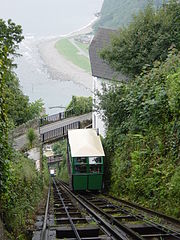Lynmouth
| Lynmouth | |
| Devon | |
|---|---|
 Lynmouth harbour | |
| Location | |
| Grid reference: | SS725495 |
| Location: | 51°13’49"N, 3°49’39"W |
| Data | |
| Postcode: | EX35 |
| Local Government | |
| Council: | North Devon |
| Parliamentary constituency: |
North Devon |
Lynmouth is a seaside village in Devon, on the north edge of Exmoor. It is at the foot of the cliffs on which stands Lynton, to which it is joined by the Lynton Gorge and since 1890 by the Lynton and Lynmouth Cliff Railway.
The village stands where the West Lyn and East Lyn rivers meet in a gorge 700 feet below Lynton. The two villages are symbiotic (and share a town council). Other associated villages are hamlets such as Barbrook and small moorland settlements such as East Ilkerton, West Ilkerton and Shallowford.
Lynmouth was described by Thomas Gainsborough, who honeymooned there with his bride Margaret Burr, as "the most delightful place for a landscape painter this country can boast". That was before it was destroyed by flood in 1952, though the village today as rebuilt is still a delight.
Contents
Cliff Railway
The Lynton and Lynmouth Cliff Railway is a water-powered funicular railway carrying passengers up and down the cliffs between Lynton and Lynmouth, and is a great support to holidaymakers.
The railway is a water-operated funicular, 862 feet long, operating on a 1 in 1.75 gradient track. One car descends, while the other ascends, on a counterbalance system. The water is piped from the West Lyn River.
The railway opened in 1890, designed by George Croydon Marks (later Baron Marks of Woolwich), and paid for mainly by Sir George Newnes, Lynton's major benefactor. Construction work, relying entirely on manual labour, began in 1887 and was completed in less than three years. The railway is still running today as then.
History
The Rescue of the Forrest Hall
A lifeboat station was established in Lynmouth on 20 January 1869, five months after the nearby wreck of the sailing vessel Home.
At 7:52pm on 12 January 1899, a 1,900 ton three-masted ship Forrest Hall, carrying thirteen crew and five apprentices, was in trouble off Porlock Weir on the North Somerset coast to a severe gale which had been blowing all day. She had been under tow, but the tow rope had broken. She was dragging her anchor and had lost her steering gear. The ship's destruction was probable. The alarm was raised for the Louisa, the Lynmouth lifeboat, to be launched to assist. However, due to the terrible weather, the launch was impossible. Jack Crocombe, the coxswain of Louisa proposed to take the boat by road to Porlock's sheltered harbour — 13 miles around the coast — and launch it from there.
The boat plus its carriage weighed about 10 tons, and transporting it would not be easy. 20 horses and 100 men started by hauling the boat up the 1 in 4 Countisbury Hill out of Lynmouth. Six of the men were sent ahead with picks and shovels to widen the road. The highest point is 1,423 feet above sea level. After crossing the 15 miles of wild Exmoor paths, the dangerous Porlock Hill had to be descended with horses and men pulling ropes to stall the descent; during this they had to demolish part of a garden wall and fell a large tree to make a way.
The lifeboat reached Porlock Weir at half past six in the morning and was launched. Although cold, wet, hungry and exhausted, the crew rowed for over an hour in heavy seas to reach the stricken Forrest Hall and rescue the thirteen men and five apprentices with no casualties; but four of the horses used died of exhaustion. The Forrest Hall was towed across the Bristol Channel into the docks at Barry, Glamorgan.[1]
The event was re-enacted 100 years later, in daylight, on today's much better roads.
1952 Lynmouth flood
On 15 and 16 August 1952, a storm of tropical intensity broke over southwest Britain, depositing 9 inches of rain within 24 hours on an already waterlogged Exmoor. It is thought that a cold front scooped up a thunderstorm, and the orographic effect worsened the storm. Debris-laden floodwaters cascaded down the northern escarpment of the moor, converging upon the village of Lynmouth; in particular, in the upper West Lyn valley, a dam was formed by fallen trees and debris, which in due course gave way, sending a huge wave of water and debris down that river. The River Lyn through the town had been culverted to gain land for business premises; this culvert soon choked with flood debris, and the river flowed through the town. Much of the debris was boulders and trees.
Overnight, over 100 buildings were destroyed or seriously damaged along with 28 of the 31 bridges, and 38 cars were washed out to sea. In total, 34 people died, with a further 420 made homeless.
Similar events had been recorded at Lynmouth in 1607 and 1796.
After the 1952 disaster, the village was rebuilt, including diverting the river around the village.
The small group of houses on the bank of the East Lyn River called Middleham between Lynmouth and Watersmeet was destroyed and never rebuilt. Today, there stands a memorial garden.
See also
Outside links
| ("Wikimedia Commons" has material about Lynmouth) |
- The Lynmouth Flood of 1952 — Exmoor National Park Authority account
- Possible connections with cloud seeding (BBC News, 30 August 2001)
- On this day 16 August 1952 (BBC News)
- Lynmouth Foreland Lighthouse

